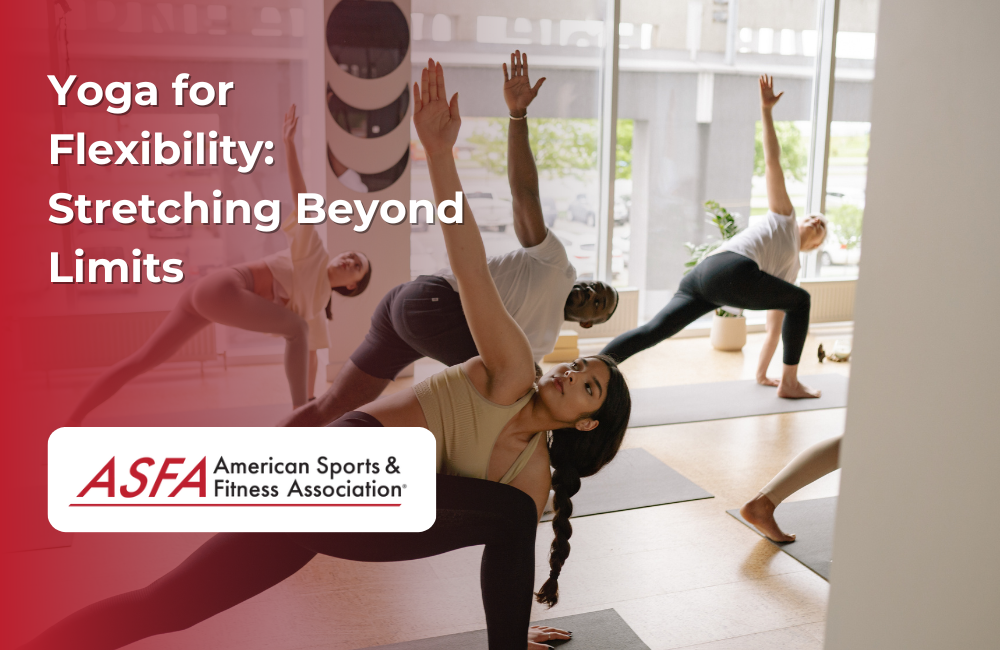Yoga is a powerful tool for enhancing flexibility and expanding the body's range of motion. For those pursuing ASFA's Yoga Certification, understanding the principles and practices of yoga for flexibility is essential. In this article, we will explore the essence of yoga for flexibility, its significance in yoga practice, and how it empowers individuals to stretch beyond their limits.
In the realm of physical wellness and mind-body connection, there exists a practice that not only nurtures flexibility but also fosters inner serenity, balance, and self-discovery – Yoga. "Yoga for Flexibility: Stretching Beyond Limits" is your guiding light into the transformative world of yoga, offering comprehensive insights and guidance for those seeking to enhance their flexibility through this ancient practice.
Yoga is more than just a series of poses; it's a holistic journey that connects the body, mind, and spirit, cultivating strength, flexibility, and inner peace. It is a discipline that invites practitioners to explore their physical and mental boundaries, encouraging them to go beyond their comfort zones and discover the profound potential of the body. Aspiring yogis, you are poised to embark on a journey that combines the wisdom of yoga with the promise of unlocking newfound flexibility and self-awareness.
Engaging in yoga signifies a commitment to personal growth, balance, and a profound sense of well-being. It's about understanding the principles of yoga philosophy, breath control, and the art of mindfulness in motion. Yoga offers a unique approach to flexibility, where the body is gently coaxed into greater range of motion, and the mind finds stillness in the midst of movement.
At its core, yoga emphasizes the importance of conscious breath, mindful movement, and a deep connection to the body. Aspiring practitioners, you'll explore how to harness the power of yoga to improve flexibility, release tension, and promote a sense of ease and fluidity in your body.
Throughout our exploration of "Yoga for Flexibility," we will delve into the foundational principles of yoga, including the philosophy of balance, the mechanics of yoga poses, and the psychology of mindfulness. We will examine how to create a nurturing and calming environment that supports your yoga practice and encourages deep stretching and relaxation.
In the following sections, we will offer detailed guidance on the practice of yoga for flexibility, understanding the role of proper alignment, and how to incorporate yoga into your daily life. Whether you're seeking to enhance your physical flexibility, relieve stress, or embark on a journey of self-discovery, this guide will provide you with the knowledge and tools to stretch beyond your limits through the transformative power of yoga.
So, join us on this flexible journey into the world of yoga, where each practice becomes an opportunity for enhanced flexibility and inner balance, where yoga stretches the body and nourishes the soul, and where practitioners discover the profound potential of stretching beyond their limits. As you embrace the practice of yoga for flexibility, may you find harmony, serenity, and a deeper connection to the fluidity of both body and mind.
The Essence of Yoga for Flexibility
Yoga for flexibility involves a deliberate and mindful approach to stretching and lengthening the muscles and connective tissues of the body. Key aspects of yoga for flexibility include:
1. Gentle and Progressive: Yoga for flexibility prioritizes gentle and progressive stretching. It encourages practitioners to respect their current limits and gradually work toward increased flexibility over time.
2. Breath Awareness: Mindful breath awareness is integral to yoga for flexibility. The breath serves as a guide, helping practitioners deepen their stretches and release tension.
3. Relaxation: Relaxation is a fundamental principle of yoga for flexibility. By relaxing into stretches, practitioners allow their muscles to release and lengthen more effectively.
4. Mind-Body Connection: Yoga for flexibility fosters a strong mind-body connection. Practitioners become attuned to the sensations in their body and learn to differentiate between discomfort and pain.
5. Balance and Alignment: Balance and proper alignment are essential in yoga for flexibility to prevent strain and injury. Each stretch is performed with attention to alignment and balance.
Significance of Yoga for Flexibility in ASFA's Yoga Certification
For individuals pursuing ASFA's Yoga Certification, Yoga for flexibility holds significance in several ways:
1. Teaching Adaptability: ASFA's certification encourages instructors to adapt their teaching to the needs and abilities of their students. Yoga for flexibility provides techniques and practices that can be modified for practitioners at various levels.
2. Injury Prevention: ASFA's certification recognizes the importance of injury prevention in yoga practice. By teaching safe and effective stretching techniques, instructors can help students reduce the risk of injuries.
3. Holistic Approach: ASFA's Yoga Certification promotes a holistic approach to yoga practice, emphasizing the importance of flexibility as a component of overall physical well-being.
4. Mindful Instruction: ASFA's certification encourages instructors to teach yoga mindfully, fostering an environment of self-awareness and self-compassion.
Unlock Your Potential with Yoga for Flexibility - Deepening Mind-Body Connection & Mobility
Yoga for flexibility is a mindful and progressive practice that empowers individuals to stretch beyond their limits safely and effectively. Whether you're pursuing ASFA's Yoga Certification or enhancing your personal Yoga practice, understanding and embracing yoga for flexibility enriches your understanding of yoga's transformative potential. By incorporating gentle and mindful stretching, breath awareness, relaxation, and proper alignment, you can unlock the benefits of increased flexibility, mobility, and a deeper mind-body connection on your yoga journey.
In conclusion, incorporating yoga into your routine with a focus on flexibility can be a transformative journey that allows you to stretch beyond your limits, both physically and mentally. As discussed in this article, understanding the benefits of Yoga for flexibility offers numerous advantages, including improved range of motion, reduced muscle tension, enhanced mental clarity, and emotional well-being.
One key takeaway is the ability of Yoga to improve flexibility gradually. Through regular practice, you can increase your range of motion, stretch tight muscles, and release tension, which is particularly valuable for individuals seeking to enhance their flexibility.
Additionally, yoga places a strong emphasis on the connection between breath and movement. Mindful breathing techniques integrated into yoga practice help calm the mind, reduce stress, and improve mental clarity, providing a holistic approach to flexibility and well-being.
Furthermore, yoga is adaptable to different fitness levels and can be modified to suit individual needs and goals. Whether you are a beginner or an advanced practitioner, yoga can be tailored to your abilities and gradually progress toward greater flexibility.
The importance of proper alignment and technique in yoga is crucial for maximizing flexibility benefits and reducing the risk of injury. Working with a qualified instructor or trainer can help ensure that you perform poses correctly and safely.
In summary, Yoga for flexibility is a dynamic practice that allows you to stretch beyond your limits, both physically and mentally. By embracing yoga, focusing on breath awareness, and working with a qualified instructor, you can experience transformative results in your flexibility, range of motion, and overall sense of well-being.





